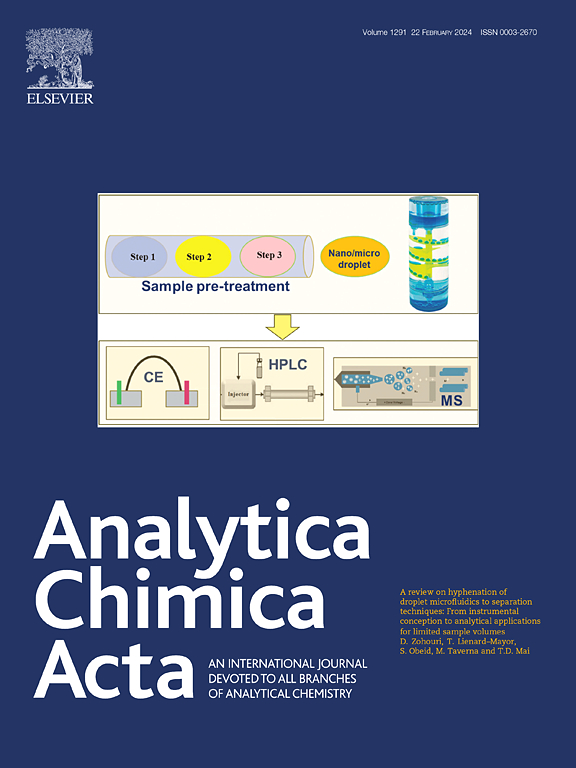Double special bodyguard: Selenium-enhanced loop-mediated isothermal amplification combined with CRISPR/Cas12a biosensing strategy
IF 5.7
2区 化学
Q1 CHEMISTRY, ANALYTICAL
引用次数: 0
Abstract
Cervical cancer is closely associated with human papillomavirus (HPV) infection, underscoring the necessity for effective HPV detection. Various biosensors utilizing isothermal amplification techniques have been developed for HPV DNA detection. These methods offer high sensitivity and specificity, making them suitable for point-of-care testing. However, the in vitro DNA polymerases used in these isothermal amplification methods lack a repair system, may leading to polymerization errors. This limitation highlights the need for improved detection methods that can enhance accuracy and reliability in HPV testing. Here, a sensing strategy called selenium nucleic acid-enhanced loop-mediated isothermal amplification (Se-LAMP) combined with CRISPR/Cas12a (SLC) was developed. The SLC has two specific bodyguards, which ensure the accuracy and specificity of biosensors through two aspects. One bodyguard is dNTPαSe, a supplement added to the initial Se-LAMP step, which guarantees the accuracy of DNA polymerase and reduces background signals. The other bodyguard is CRISPR system, integrating three functions of specific verification, signal amplification and signal output. CRISPR activation can only rely on Se-LAMP products successfully rechecked by crRNA. As a readable signal of SLC, the detection limit was as low as 0.38 copies/μL (0.64 fM) within 65 min, which was one order of magnitude lower than that of non-selenium-modified methods and two orders of magnitude lower than that of qPCR. The SLC is the first to use CRISPR system as the output mode of Se-LAMP, proving the CRISPR/Cas12a system has good recognition ability for selenium-modified nucleic acid. The ultrasensitive dual-specificity guard enables SLC, ensuring accuracy in biodetection. This innovation offers novel clinical testing approaches and holds significance for diagnosing and monitoring disease progression.


双重特殊护卫:硒增强环介导等温扩增结合CRISPR/Cas12a生物传感策略
宫颈癌与人乳头瘤病毒(HPV)感染密切相关,强调了有效检测HPV的必要性。利用等温扩增技术的各种生物传感器已被开发用于HPV DNA检测。这些方法具有高灵敏度和特异性,适用于即时检测。然而,在这些等温扩增方法中使用的体外DNA聚合酶缺乏修复系统,可能导致聚合错误。这一限制突出表明需要改进检测方法,以提高HPV检测的准确性和可靠性。本研究建立了硒核酸增强环介导等温扩增(Se-LAMP)与CRISPR/Cas12a (SLC)结合的传感策略。SLC有两个特定的保镖,通过两个方面来保证生物传感器的准确性和特异性。dNTPαSe是初始Se-LAMP步骤的补充物,它保证了DNA聚合酶的准确性并减少了背景信号。另一个保镖是CRISPR系统,集成了特异性验证、信号放大和信号输出三个功能。CRISPR激活只能依赖于经crRNA复检成功的Se-LAMP产物。作为SLC的可读信号,65 min内的检出限低至0.38拷贝/μL (0.64 fM),比非硒修饰方法低1个数量级,比qPCR低2个数量级。SLC首次使用CRISPR系统作为Se-LAMP的输出模式,证明CRISPR/Cas12a系统对硒修饰核酸具有良好的识别能力。超灵敏的双特异性保护使SLC能够确保生物检测的准确性。这一创新提供了新的临床检测方法,对诊断和监测疾病进展具有重要意义。
本文章由计算机程序翻译,如有差异,请以英文原文为准。
求助全文
约1分钟内获得全文
求助全文
来源期刊

Analytica Chimica Acta
化学-分析化学
CiteScore
10.40
自引率
6.50%
发文量
1081
审稿时长
38 days
期刊介绍:
Analytica Chimica Acta has an open access mirror journal Analytica Chimica Acta: X, sharing the same aims and scope, editorial team, submission system and rigorous peer review.
Analytica Chimica Acta provides a forum for the rapid publication of original research, and critical, comprehensive reviews dealing with all aspects of fundamental and applied modern analytical chemistry. The journal welcomes the submission of research papers which report studies concerning the development of new and significant analytical methodologies. In determining the suitability of submitted articles for publication, particular scrutiny will be placed on the degree of novelty and impact of the research and the extent to which it adds to the existing body of knowledge in analytical chemistry.
 求助内容:
求助内容: 应助结果提醒方式:
应助结果提醒方式:


